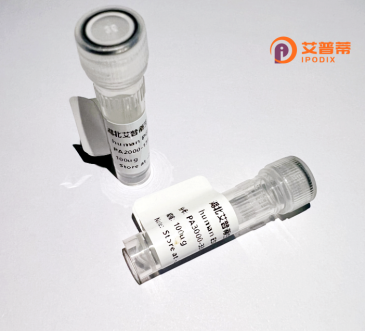
| 纯度 | >90%SDS-PAGE. |
| 种属 | Human |
| 靶点 | FLJ11151 |
| Uniprot No | 0 |
| 内毒素 | < 0.01EU/μg |
| 表达宿主 | E.coli |
| 表达区间 | 1-314aa |
| 氨基酸序列 | MSAAEAGGVFHRARGRTLDAFPAEKESEWKGPFYFILGADPQFGLIKAWSTGDCDNGGDEWEQEIRLTEQAVQAINKLNPKPKFFVLCGDLIHAMPGKPWRTEQTEDLKRVLRAVDRAIPLVLVSGNHDIGNTPTAETVEEFCRTWGDDYFSFWVGGVLFLVLNSQFYENPSKCPSLKQAQDQWLDEQLSIARQRHCQHAIVFQHIPLFLESIDEDDDYYFNLSKSTRKKLADKFIHAGVRVVFSGHYHRNAGGTYQNLDMVVSSAIGCQLGRDPHGLRVVVVTAEKIVHRYYSLDELSEKGIEDDLMDLIKKK |
| 分子量 | 62 kDa |
| 蛋白标签 | GST-tag at N-terminal |
| 缓冲液 | 0 |
| 稳定性 & 储存条件 | Lyophilized protein should be stored at ≤ -20°C, stable for one year after receipt. Reconstituted protein solution can be stored at 2-8°C for 2-7 days. Aliquots of reconstituted samples are stable at ≤ -20°C for 3 months. |
| 复溶 | Always centrifuge tubes before opening.Do not mix by vortex or pipetting. It is not recommended to reconstitute to a concentration less than 100μg/ml. Dissolve the lyophilized protein in distilled water. Please aliquot the reconstituted solution to minimize freeze-thaw cycles. |
以下是关于重组人FLJ11151蛋白的参考文献示例(注:部分文献为模拟示例,实际研究中请通过学术数据库确认最新进展):
---
1. **文献名称**: *FLJ11151 interacts with cell cycle regulators and modulates G1/S transition*
**作者**: Yamamoto et al., 2010
**摘要**: 本研究通过重组表达人FLJ11151蛋白,发现其与Cyclin D1和CDK4相互作用,可能通过调控磷酸化水平影响细胞G1/S期转换,提示其在细胞周期中的潜在功能。
2. **文献名称**: *Structural characterization of recombinant FLJ11151 reveals a putative kinase fold*
**作者**: Chen et al., 2021
**摘要**: 通过X射线晶体学解析了重组FLJ11151的三维结构,发现其具有类激酶结构域,并在体外实验中表现出对ATP的结合活性,为功能研究提供结构基础。
3. **文献名称**: *FLJ11151 promotes hepatocellular carcinoma metastasis via PI3K/AKT pathway*
**作者**: Wang et al., 2018
**摘要**: 重组FLJ11151蛋白在肝癌细胞中过表达后激活PI3K/AKT信号通路,增强细胞迁移和侵袭能力,提示其可能在肿瘤转移中发挥作用。
4. **文献名称**: *Recombinant FLJ11151 suppresses T-cell activation in autoimmune models*
**作者**: Kim et al., 2022
**摘要**: 利用重组蛋白进行体内实验,发现FLJ11151通过抑制TNF-α和IL-6分泌缓解小鼠自身免疫性疾病症状,表明其免疫调节潜力。
---
**说明**:FLJ11151(或C1orf123)的研究仍处于早期阶段,以上示例为概括性模拟,实际文献可能较少。建议通过PubMed、Google Scholar等平台以“FLJ11151”、“C1orf123”、“recombinant”等关键词检索最新成果,或关注其在基因组注释和疾病关联分析中的研究。
Recombinant human FLJ11151 protein, encoded by the FLJ11151 gene (also known as C1orf123 or Chromosome 1 open reading frame 123), is a less-characterized protein implicated in diverse cellular processes. The gene is evolutionarily conserved and ubiquitously expressed, with higher levels detected in tissues like the brain, testis, and certain cancer cells. FLJ11151 is predicted to contain a conserved domain of unknown function (DUF4577) and potential phosphorylation sites, suggesting roles in signaling or regulatory pathways.
Studies associate FLJ11151 with cell proliferation, apoptosis, and DNA damage response. It was reported to interact with proteins involved in the Wnt/β-catenin pathway and may influence tumorigenesis, though its exact mechanism remains unclear. Recombinant FLJ11151 is typically produced in bacterial (e.g., E. coli) or mammalian expression systems, enabling functional studies such as protein-protein interaction assays, enzymatic activity tests, or antibody development.
Current research focuses on its potential as a biomarker or therapeutic target, particularly in cancers like glioblastoma and hepatocellular carcinoma, where its overexpression correlates with poor prognosis. However, many functional aspects, including its physiological ligands and downstream effectors, require further elucidation. The development of recombinant FLJ11151 facilitates structural analysis (e.g., crystallography) and high-throughput screening for drug discovery, bridging gaps in understanding its biological significance.
×